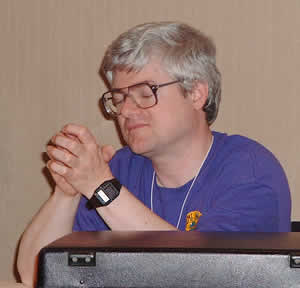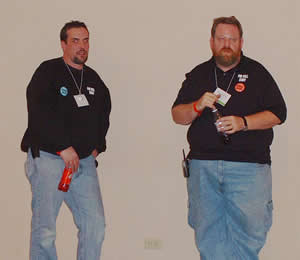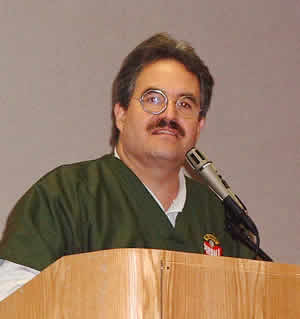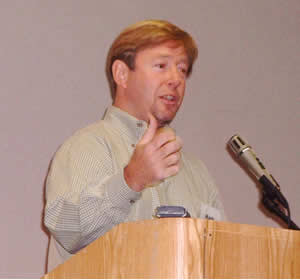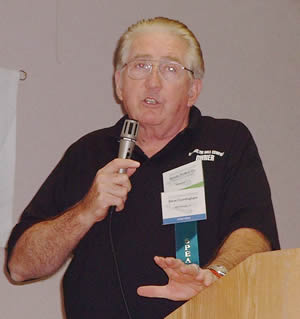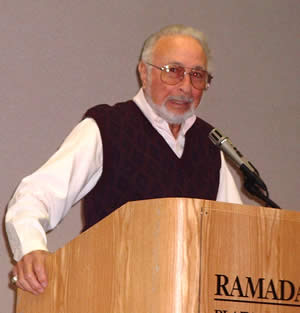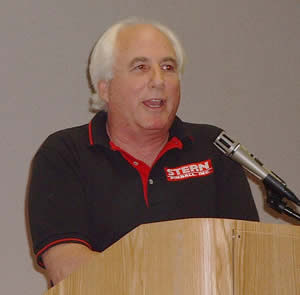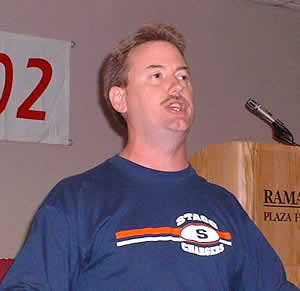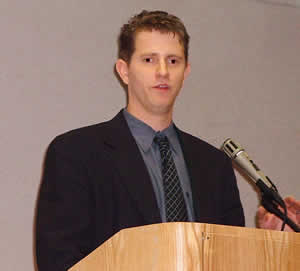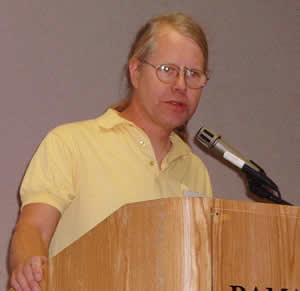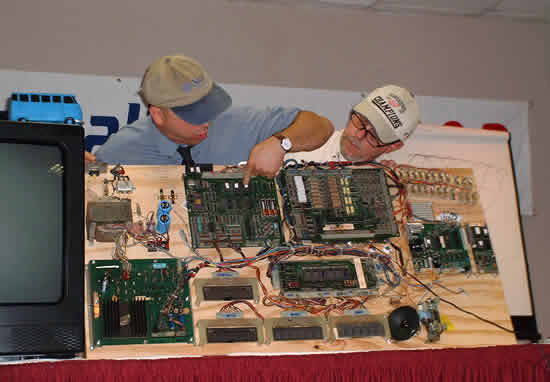
PINBALL
EXPO 2002
PART THREE
|
12th November 2002 In part three of this review of Pinball Expo 2002 we will look at the rest of the seminars. We were going to cover the banquet and tournament in this part too, but this section is long enough already so it will appear in the final part. As a special treat there are some audio clips for you to download and hear the key points of the talks. So with lots to cover let's get on with it. Thursday Evening
Nobody was keen to suggest that all such items be removed from public access, but the implications of making other companies' property freely available were discussed. Naturally the recent problems of the reproduction Twilight Zone clock housings were raised and - as luck would have it - two representatives of Illinois Pin Ball were on hand to answer questions.
Steve and Bob reiterated some of the details of IPB contract with Williams and said that a surprising amount of parts are in stock, but nobody asks for them. These discussions dominated the evening and much of it was better left to the next day's talk by Gene Cunningham. The get-together concluded with brief thoughts about the usefulness of game owners lists and the distribution of usenet messages and why some messages never appear on various servers. I think the format of the meeting makes it hard for people to chime-in with their thoughts. If the seating were arranged in a circle rather than rows and desks, everyone would see who was talking and it would have more of a friendly feel. That said, it was a useful meeting and it's good to put faces to Internet names. Friday morning It's an early start for the second day of seminars but even at this time of day many of the seats are taken when events kicked-off.
He now sells all his games with the same key locks, so he always has the correct keys even if the customer has lost theirs. He sells ten times as many solid state games as he does electromechanical.
He worked for Williams for five years after which he finally got his wish and worked on video games, though he still did some pinball art for another five years. He still works on video and redemption games. An avid hunter, Mark missed the start of the hunting season whilst working on High Speed 2 - The Getaway so added some deer to the plastics artwork. He described the problems with getting accurately positioned printing and explained how the black edging lines were made so thick so they would hide the misalignments. Games he worked on include: Space Shuttle, High Speed, Banzai Run, Diner, Fire, Harley Davidson, Getaway (Doug Watson did the backglass) and Dracula. Mark talked about Banzai Run and how it was originally based on a construction zone theme. Mark talked Pat Lawlor and Larry DeMar into using a motocross theme instead - originally called Banzai Enduro.
Then he described the original process for making the Kiss backglass and how Illinois Pinball used computer techniques to distort the image to make the current techniques match the printing process used for the originals. New parts are marked with the IPB name so there will be no confusion. Backglasses cost $400 and playfields $450. A questionnaire was handed out asking which parts were wanted most urgently - the greater the demand the more likely it is to be remade. He said IPB had spent about $300,000 on making new parts this year and expected to spend the same next year. He now has over 7,000,000 parts in stock, including about 2,500 ramps. There are 10 or 11 new products in the process of being remanufactured and he expects the to make the same number next year. He spoke about problems with
people making parts and their infringement of patents. Williams have
taken action over replacement parts not made under licence but Gene
said he and IPB had no involvement in that action. Finally Gene talked about Big Bang Bar. He bought the remaining stock when Capcom closed their pinball division and could remake the game but didn't commit one way or the other. If there was enough demand he could make another run of the game - probably around 100 machines.
He spoke about his memories
of his father (David Gottlieb) and the Gottlieb factory. For a while
pinball has a bad reputation with illegal methods of rewarding the player.
When a free game was ruled illegal in Connecticut, Alvin came up with
the add-a-ball system as an alternative. He spoke with Wayne Nyens about
the idea who thought it had merit but his father rejected it saying
nobody would play without a free play system. Alvin persisted and finally
convinced him and so the add-a-ball system became widely accepted.
Casual players are of major interest to Stern Pinball as most of their games now go to street locations (i.e. not arcades, but places like bars, movie theatres and stores). Their games are designed to be instantly accessible to the very occasional player while keeping a depth which appeals to the rest of us. Gary revealed that game sales are currently running at six to eight thousand a year, with the intention to bring that up to ten thousand soon. Touchscreen games have taken a large bit out of pinball's market, especially in new locations. He reconfirmed his intention
to continue with licensed themes for future games, saying that the licence
brings with it extra costs and approval effort, but gives the game designer
immediate ideas and a framework to design around, while improving the
game's resale price to the collectors. Monopoly is a good seller to
individual buyers, Harley Davidson even more so. Gary was surprised
by the success of the Rollercoaster Tycoon licence. The talk then moved on to the new ToPS tournament system, pausing only to remind the audience of the monumental task Gene Cunningham and IPB have in organising the sales and reproduction of parts for older games. Gary asked that everybody be patient and allow IPB time to build up the flow of parts. To talk about the ToPS system, Gary handed the microphone to Joe Blackwell SPI's head of customer parts sales and technical support, who co-developed the system.
He criticised operators for not wanting to be involved with pinball, reminding them of their roots - providing a service to their customers. Recalling the problems with
the attempted networked-tournament system developed with Incredible
Technologies, he insisted that operators really want a single location
tournament where customers compete against each other, not a national
or international one, though he didn't rule out a local-area network
of one operator's games across different locations, though that is not
expected in the short term. Joe described the different types of tournaments he had run and various locations and how the ToPS system can be adapted to these types. He dismissed legal issues with running cash competitions but stressed that each operator should check with their local licensing authority. Gary explained that there are different issues in Europe but that operators usually find a way round them. Gary continued, giving us
his thoughts of Williams' Pinball 2000 system, the problems that he
had with it, and how he knew that Williams were going to get out of
pinball.
Gary confirmed the company is working on a new hardware system, but moved quickly on without wanting to give any details. Stern Pinball is making games specifically for the home market as a way of keeping the factory capacity utilised - the recent run of special edition Harley Davidson games and a run of 100 Austin Powers games for The Sharper Image were examples.
He emphasised the need to keep ball speed down to the minimum possible, so that you have more time available to set up the next shot. After discussing multiball strategy and the different tournament types he moved on to player temperament and the importance of focusing on your game, the aims and shot choices and finally having enough patience, not being hurried into taking your turn or to let the game dictate the pace.
1. Bad operators - responsible
for broken and dirty pinball games. There then followed a presentation of recently rediscovered pictures taken during a factory tour of D. Gottlieb & Co. in 1971. Finally Tim updated us on the progress of the Pinball Hall of Fame. This will hopefully be a museum devoted to celebrating pinball and requires initial funding of $1 million. Last year the total raised stood at $8 thousand, this year it was up to $90 thousand.
2.30pm:
Rob and Clay started off their presentation with a video showing various sections and out takes from the This Old Pinball series of tapes. Throughout the tape they would stop and distribute various pinball goodies such as plastics, tapes and toys. By "distributed" I mean thrown - violently! Naturally enough, the tape featured the destruction of various pinball games in a variety of ways, starting with a Data East Hook falling out of a tree house (as it would).
3.30pm: The talk and the goodies continued to flow into the second part of Rob & Clay's presentation - this time about the Williams System 3 to System 7 games. They brought along an extensive test bed so boards and techniques can be tried without using a real game. The information they were telling us tied in with a new section of their Marvin3m web site.
They went through each of the different systems explaining what changes were made along the way and the various compatibilities and incompatibilities. There are a number of modifications that the chaps recommend should be made to improve the systems' stability and reliability. Finally they powered up the test bed and.... it didn't work - at least to start with. It did eventually start-up after a bit of encouragement. To close the seminar another batch of goodies went flying over the audience and into the hands of some lucky souls. I don't know if it was just me, but Rob & Clay's presentation seemed a bit lacking this year - almost as if they were just going through the motions and not really enjoying it. Perhaps running two seminars back to back is a bit too much and they should have been shortened. But despite that you wouldn't want to miss them.
And that concludes our look at the Pinball Expo seminars. In the final part of our report we will look at the fireside chats (with Barry Ousler and Steve Ritchie) and the tournament competition.
© Pinball News 2002 |
